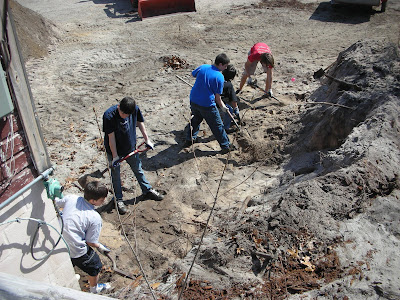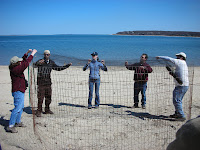
 Southold resident, Michael Romeo, is on his was to becoming an Eagle Scout. To attain the Eagle Rank " a Life Scout [must] plan, develop, and give leadership to others in a service project helpful to any religious institution, and school, or your community." Michael choose Peconic Dunes County Park as the site to perform his service project, replacing the sad remnants of the retaining wall outside the Nature Center with a beautiful new wall that is sure to stand for decades to come. Michael coordinated his fellow scouts from Southold Troop #6 with assistance from his father, Richard Romeo, and Roger Martin, CCE Education Specialist. Cornell Cooperative Extension of Suffolk County, the Suffolk County Department of Parks & Recreation, and all the campers and community groups who benefit from Peconic Dunes wish to offer Michael and his team a big THANKS!
Southold resident, Michael Romeo, is on his was to becoming an Eagle Scout. To attain the Eagle Rank " a Life Scout [must] plan, develop, and give leadership to others in a service project helpful to any religious institution, and school, or your community." Michael choose Peconic Dunes County Park as the site to perform his service project, replacing the sad remnants of the retaining wall outside the Nature Center with a beautiful new wall that is sure to stand for decades to come. Michael coordinated his fellow scouts from Southold Troop #6 with assistance from his father, Richard Romeo, and Roger Martin, CCE Education Specialist. Cornell Cooperative Extension of Suffolk County, the Suffolk County Department of Parks & Recreation, and all the campers and community groups who benefit from Peconic Dunes wish to offer Michael and his team a big THANKS!Now, for some photos documenting the destruction of the old and the construction of the new...

BEFORE
 The materials for the new wall.
The materials for the new wall.

Demolishing the old "wall".

No more wall.

Getting rid of the debris.

Look what Roger found.

The boys planning their next step.

Perfect timing...the reinforcements!

Michael explaining to the troop how the wall's foundation will be laid.

The Troop #6 boys get right to work.

Michael and his dad laying the foundation of the wall.

The boys tamp down the foundation so the rest of the wall will be solid.

Michael driving in 1 of the over 400 12-inch nails needed to hold the wall together.

Michael taking a higher vantage point to inspect his team's progress.

The boys taking a well deserved lunch break. Oatmeal raisin cookies courtesy of Michael's mom. (They were pretty awesome.)

Roger and Michael planning how they'll work around the terrain and negotiate the necessary angles in the wall.

The pieces of wood turned into the dune help anchor the wall.

Finishing the trench on the other side of the wall.

The end of Day #1.

After everyone rested on Sunday from a full day of work on Saturday, the crew showed up ready to go Monday morning, quickly building upon where they had left off.

The black fabric is a semi-permeable membrane. It allows water to pass through, but not sand. Without it, small grains of sand would creep between the wall slabs and slowly pry open gaps that would eventually cause the wall to fall apart. Michael and his crew thought of everything!

The east side of the wall nearly complete.

Building a new wall made it necessary to build new steps up to the boardwalk entrance to the Nature Center.

Addressing some of the finishing touches.

Backfilling the area above the wall where one of our edible berry bushes lives.

The wall and stairs complete!

Thank you (l-r) Roger Martin, Richard Romeo, Buddy, Billy McDonald, Fido, and Steve Romeo for the excellent wall!
 The materials for the new wall.
The materials for the new wall.
Demolishing the old "wall".

No more wall.

Getting rid of the debris.

Look what Roger found.

The boys planning their next step.

Perfect timing...the reinforcements!

Michael explaining to the troop how the wall's foundation will be laid.

The Troop #6 boys get right to work.

Michael and his dad laying the foundation of the wall.

The boys tamp down the foundation so the rest of the wall will be solid.

Michael driving in 1 of the over 400 12-inch nails needed to hold the wall together.

Michael taking a higher vantage point to inspect his team's progress.

The boys taking a well deserved lunch break. Oatmeal raisin cookies courtesy of Michael's mom. (They were pretty awesome.)

Roger and Michael planning how they'll work around the terrain and negotiate the necessary angles in the wall.

The pieces of wood turned into the dune help anchor the wall.

Finishing the trench on the other side of the wall.

The end of Day #1.

After everyone rested on Sunday from a full day of work on Saturday, the crew showed up ready to go Monday morning, quickly building upon where they had left off.

The black fabric is a semi-permeable membrane. It allows water to pass through, but not sand. Without it, small grains of sand would creep between the wall slabs and slowly pry open gaps that would eventually cause the wall to fall apart. Michael and his crew thought of everything!

The east side of the wall nearly complete.

Building a new wall made it necessary to build new steps up to the boardwalk entrance to the Nature Center.

Addressing some of the finishing touches.

Backfilling the area above the wall where one of our edible berry bushes lives.

The wall and stairs complete!

Thank you (l-r) Roger Martin, Richard Romeo, Buddy, Billy McDonald, Fido, and Steve Romeo for the excellent wall!
-chris


























